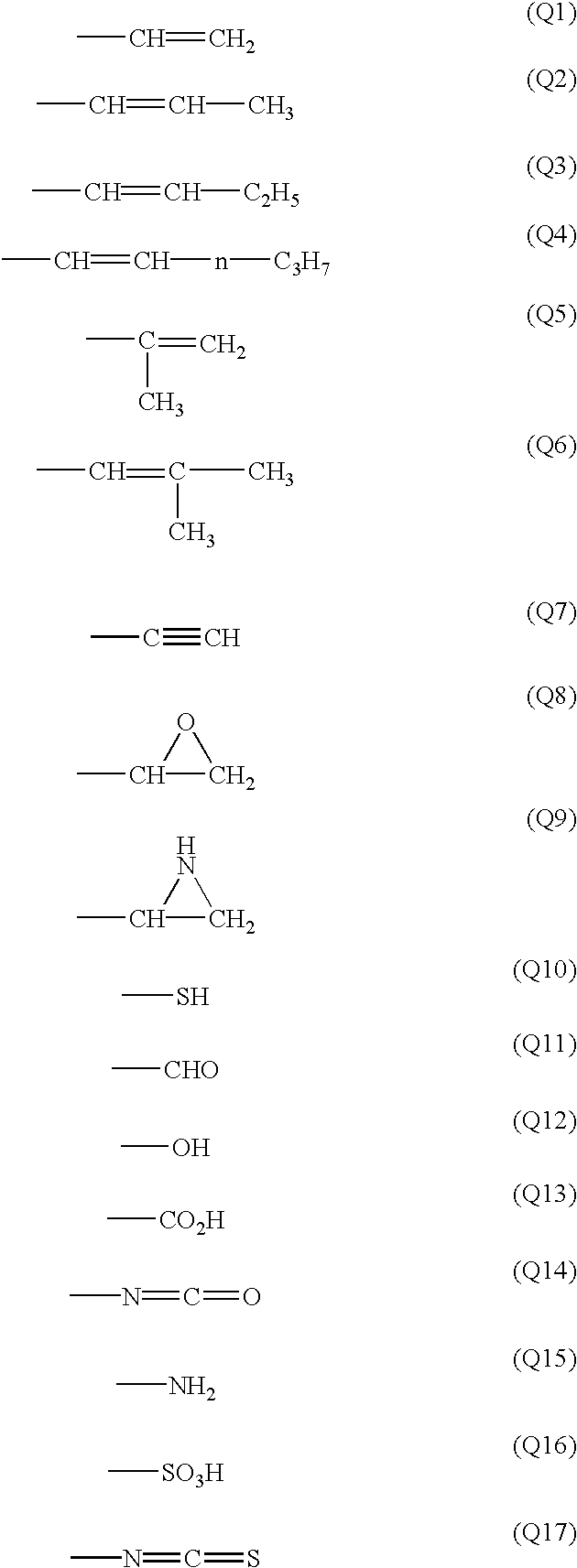Quarter wave plate comprising two optically anisotropic layers
a technology of optical anisotropy and quarter wave plate, which is applied in the direction of optics, polarising elements, instruments, etc., can solve the problems of troublesome process of pasting chips together, difficult to adjust the directions of two polymer films, and difficult to adjust the directions of three polymer films. achieve the effect of improving adhesion
- Summary
- Abstract
- Description
- Claims
- Application Information
AI Technical Summary
Benefits of technology
Problems solved by technology
Method used
Image
Examples
example 2
[0316] A cellulose triacetate film was used as a transparent support. The retardation value of the transparent support is essentially zero measured at the wavelength of 632.8 nm.
[0317] A diluted solution of a polyamic acid denatured with steroid was coated on the transparent support by using a bar coater, and air-dried at 60.degree. C. for 2 minutes. The surface was subjected to a rubbing treatment to form an orientation layer comprising the following denatured polyimide (thickness: 1 .mu.m). 11
[0318] The coating solution used in Example 1 was coated on the orientation layer to essentially vertically align the discotic liquid crystal molecules. The layer was irradiated with an ultraviolet ray for 1 second by using a mercury lump of 500 W / cm.sup.2 to polymerize the discotic liquid crystal molecules. Thus, an optically anisotropic layer A was formed.
[0319] The discotic liquid crystal molecules were homogeneously aligned. The optical axis (director) of the molecule was parallel with th...
example 3
[0334] EXAMPLE 3
[0335] The diluted solution of the polyamic acid used in Example 2 was coated on the optically anisotropic layer B prepared in Example 2 by using a bar coaler, and air-dried at 60.degree. C. for 2 minutes. The surface was subjected to a rubbing treatment to form an orientation layer (thickness: 1 .mu.m) comprising the denatured polyimide shown in Example 2.
[0336] The coating solution used in Example 1 was coated on the orientation layer to essentially vertically align the discotic liquid crystal molecules. The layer was irradiated with an ultraviolet ray for 1 second by using a mercury lump of 500 W / cm.sup.2 to polymerize the discotic liquid crystal molecules. Thus, an optically anisotropic layer A was formed.
[0337] The discotic liquid crystal molecules were homogeneously aligned. The optical axis (director) of the molecule was parallel with the lengthwise direction of the optically anisotropic layer B. The slow axis of the optically anisotropic layer A was perpendic...
example 4
[0342] Pellets of polycarbonate were dissolved in methylene chloride. The solution was cast on a metal band, and dried to obtain a polycarbonate film (thickness: 100 .mu.m). The film was uniaxially stretched at 175.degree. C. along a longitudinal direction by 6% to obtain an optically anisotropic layer B. The optically anisotropic layer B has a retardation value of 278 nm measured at the wavelength of 632.8 nm. The optically anisotropic layer B has a slow axis along a lengthwise direction.
[0343] The retardation values of the optically anisotropic layer B were measured at wavelengths of 450 nm and 550 nm. The results are shown below.
[0344] Re450B: 308 nm
[0345] Re550B: 288 nm
[0346] Re450B / Re550B: 1.07
[0347] The diluted solution of the polyamic acid used in Example 2 was coated on the optically anisotropic layer B by using a bar coater, and air-dried at 60.degree. C. for 2 minutes. The surface was subjected to a rubbing treatment to form an orientation layer (thickness: 1 .mu.m) compri...
PUM
 Login to View More
Login to View More Abstract
Description
Claims
Application Information
 Login to View More
Login to View More - R&D
- Intellectual Property
- Life Sciences
- Materials
- Tech Scout
- Unparalleled Data Quality
- Higher Quality Content
- 60% Fewer Hallucinations
Browse by: Latest US Patents, China's latest patents, Technical Efficacy Thesaurus, Application Domain, Technology Topic, Popular Technical Reports.
© 2025 PatSnap. All rights reserved.Legal|Privacy policy|Modern Slavery Act Transparency Statement|Sitemap|About US| Contact US: help@patsnap.com



